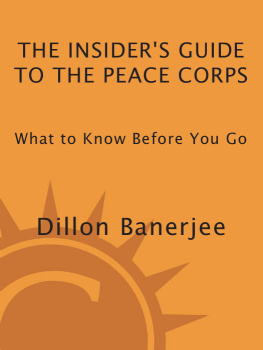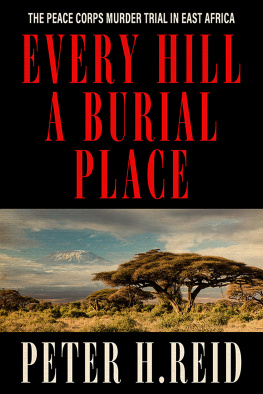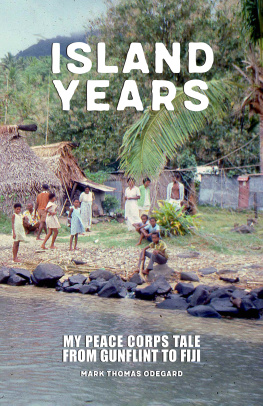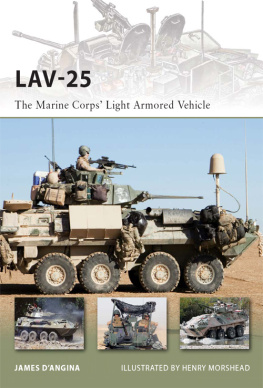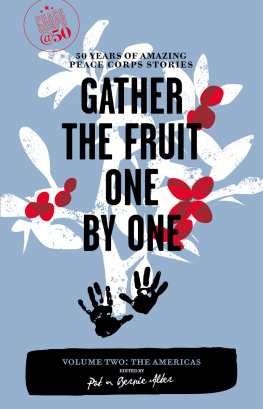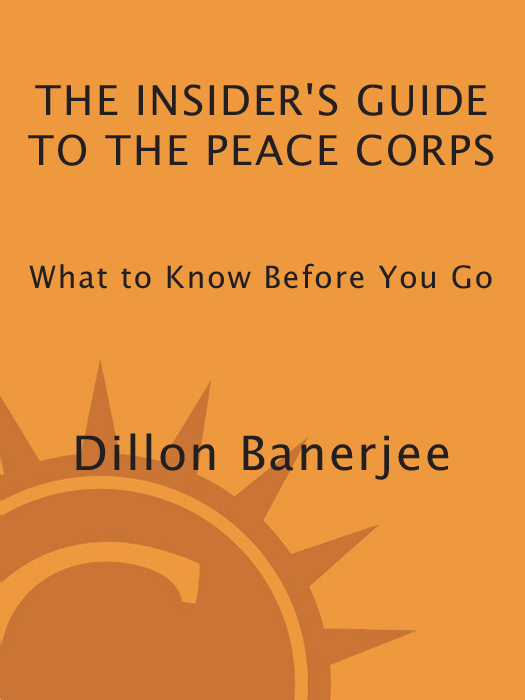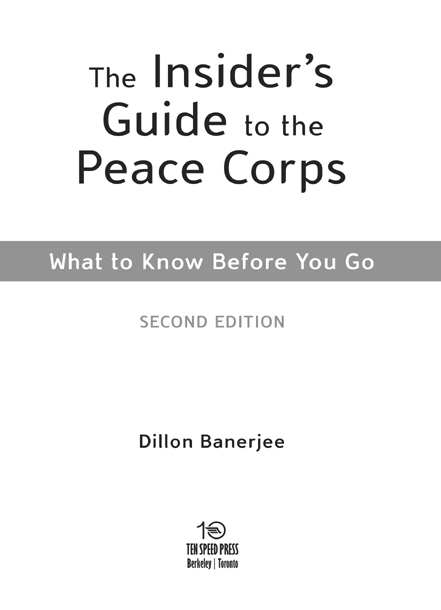Copyright 2000, 2009 by Dillon Banerjee
All rights reserved. No part of this book may be reproduced in any form, except brief excerpts for the purpose of review, without written permission of the publisher.

Ten Speed Press
PO Box 7123
Berkeley, California 94707
www.tenspeed.com
Distributed in Australia by Simon and Schuster Australia, in Canada by Ten Speed Press Canada, in New Zealand by Southern Publishers Group, in South Africa by Real Books, and in the United Kingdom and Europe by Publishers Group UK.
Previously published as So, You Want to Join the Peace Corps (Ten Speed Press, 2000)
Library of Congress Cataloging-in-Publication Data
Banerjee, Dillon.
The insiders guide to the Peace Corps: what to know before you go / Dillon Banerjee.2nd ed.
p. cm.
Rev. ed. of: So, you want to join the Peace Corps. c2000.
Summary: A guide that tells potential Peace Corps volunteers what to expect, through first-hand advice from recent volunteersProvided by publisher.
eISBN: 978-0-307-76853-7
1. Peace Corps (U.S.)Handbooks, manuals, etc. I. Banerjee, Dillon. So, you want to join the Peace Corps. II. Title.
HC60.5.B34 2009
361.6dc22
2008043720
v3.1_r1
Contents
Acknowledgments
I am grateful to Ten Speed Press for recognizing that the time was right for a second edition, and for convincing me that an update was possible from a continent away. Many thanks and much credit goes to Lindsey McKay, my research assistant, who through her innovative and effective research and analysis techniques helped provide the core data I needed for the rewrite. Thanks as well to my editor at Ten Speed Press, Sara Golski, for her expert guidance. I also want to thank those who provided me with insight into the latest from Peace Corps headquarters (you know who you are!) and the many RPCVs who responded to the surveys and calls for input.
Peace Corps Acronyms
| APCD | Associate Peace Corps Director |
| CED | Community Economic Development |
| CD | Country Director |
| COS | Close of Service |
| EMA | Europe/Mediterranean/Asia Region |
| ET | Early Termination |
| HCN | Host Country National |
| IAP | Inter-America/Pacific Region |
| IST | In-Service Training |
| NCE | Noncompetitive Eligibility |
| NGO | Nongovernmental Organization |
| PC | Peace Corps |
| PCMO | Peace Corps Medical Officer |
| PCT | Peace Corps Trainee |
| PCV | Peace Corps Volunteer |
| PCVL | Peace Corps Volunteer Leader |
| PIP | Performance Improvement Plan |
| RPCV | Returned Peace Corps Volunteer |
| TEFL | Teaching English as a Foreign Language |
| TOT | Training of Trainers |
Preface
When Ten Speed Press asked me to update this book for a second edition, I was initially hesitant. I wrote the first book, having just completed my two-year tour as a volunteer in Cameroon, with a wealth of experiential knowledge that was fresh, pertinent, and ripe for sharing. Detailing the Peace Corps experience was a reliance more on memory than research, and there was little about the Peace Corps world that I felt was unknown to mefrom the application process right through to job searching post-Peace Corps.
Nine years later, however, I felt sure that the Peace Corps had evolved to a point where it would be far less familiar to me. I knew, for example, that the application process had migrated online, that volunteers the world over had cell phones, that Peace Corps-issued motorcycles were a thing of the past, and that PCVs were as likely to be teaching GIS mapping and website development as digging fishponds or planting trees. To make the proposition of an update even more daunting, I was living thirty-five hundred miles away from the United States, not scheduled to return until 2011 when my assignment to the U.S. Embassy in Portugal was complete.
All the same, the publisher insisted that a second edition would serve as an important resource for new and prospective Peace Corps applicants and that much of the core research could be done remotely. With invaluable input from my research assistant, Lindsey McKay, an RPCV who served in the Dominican Republic from 2004 to 2006, I started collecting information on todays Peace Corps. As I analyzed feedback from RPCV discussion groups and interviews, and combed through the latest statistics, policy manuals, volunteer handbooks, surveys, and websites, I began to realize that, in actuality, very little of the Peace Corps volunteer experience had changed over the past decade. There may be new ways to apply, new gadgets to pack, and new rules to follow, but PCVs the world over go through the same basic stages of orientation, adjustment, and integration that has defined the experience since the inception of the organization over forty years ago.
Sowhy should you read this book? As with the first edition, my core motivation was to furnish prospective Peace Corps volunteers with a comprehensive resource that will help unravel what is still a largely mysterious and daunting work and life commitment. Despite a plethora of new websites, blogs, and multimedia snippets where individual volunteers share their thoughts, fears, or daily lives in country X or program Y, there is still a surprising lack of information tailored to someone who just wants to know what its like to be a Peace Corps volunteerperiod. Life throughout the developing world shares a surprising number of commonalities when it comes to basics like health, safety, infrastructure, and transportation. And life overseas as an expatriate entails basic adjustments to culture, society, and environment that cannot be avoided. All of these areas and related experiences are detailed in this book, along with many more. You should find the information provided in the following pages helpful regardless of whether you end up teaching English in Mali or training entrepreneurs in Bulgaria. As with the first edition, the information is provided in a straightforward, question-and-answer format, but now includes the latest on everything from the online application process and what to pack to safety considerations and staying in touch with home.
Deciding to join the Peace Corps and live overseas for two years is not easy. The greatest hurdle is often a mental one: stepping into the unknown and hoping to find the strength, commitment, and flexibility to see it though. I hope the information here will put things into perspective and allow you to consider the Peace Corps in a less intimidating light. Regardless of what you decide, I hope you continue to pursue ways to help make this world a better one, all the while seeking adventure and fun in your life.
Happy trails,
Dillon
Part I
Pre-Application Jitters
1
What is the application process like? How long does it take?
The application process can be arduous and seemingly endless. The Peace Corps receives over two hundred thousand inquiries each year from people interested in applying. Tens of thousands of those people submit applications, and only a fraction is eventually accepted. Besides the fact that the Peace Corps is a government agencywhich, by definition, means it can be slow and bureaucraticthe sheer number of applicants combined with the excruciating detail each must provide on the application forms make it easy to understand why the review process can last up to a year.

